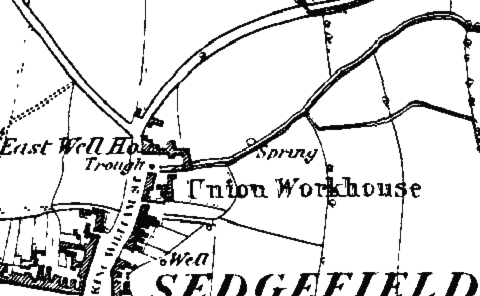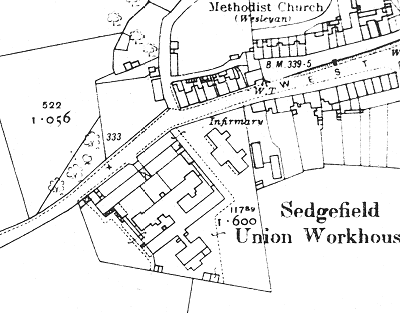Sedgefield, Durham
Up to 1834
In 1663, Brian Harrison gave £100 for the poor of Sedgefield, of which £80 was used to purchase the workhouse, and a cottage near Ryall. A parliamentary report of 1777 recorded local workhouses in operation at Sedgefield (for up to 30 inmates), Bishopton (20), and Newbiggin (12).
After 1834
Sedgefield Poor Law Union formally came into existence on 7th February 1837. Its operation was overseen by an elected Board of Guardians, 24 in number, representing its 23 constituent parishes as listed below (figures in brackets indicate numbers of Guardians if more than one):
Parish of Sedgefield:
Bradbury, Butterwick, Embleton, Fishburn, Foxton and Shotton, Mordon, Sedgefield (2).
Parish of Aycliffe:
Preston-le-Skerne, Woodham.
Parish of Bishop Middleham:
Bishop Middleham, Cornfort, Garmonsway Moor, Mainsforth, Thrislington.
Parish of Bishopton:
Bishopton, Newbiggin, Little Stainton.
Parish of Merrington:
Chilton, Ferryhill.
Parish of Redmarshall:
Elstob, Stillington, Great Stainton, Trimdon.
The population falling within the Union at the 1831 census had been 5,286 — with parishes ranging in size from Thrislington (population 15) to Sedgefield itself (1,429). The average annual poor-rate expenditure for the period 1833-35 had been £2,088 or 7s.11d. per head of the population.
The first Sedgefield union workhouse was at the northern side of the town on the east side of King William Street. The buildings, formerly used as the parish workhouse, were enlarged in 1838 with an expenditure of £291 being autorised by the Poor Law Commissioners.

Sedgefield first Union workhouse site, 1859.
In 1860, a new Union workhouse was erected at the southern end of the town, at the south side of West End. It was built of brick and could accommodate around 90 inmates. From maps, it appears to have had an entrance range with a central archway fronting onto the street at the north. At the centre was a T-shaped main block, with further structures, possibly service buildings such as laundry and workshops, to the rear. The site layout is shown on the 1914 map below.

Sedgefield second union workhouse site, 1914.
In 1894, the British Medical Journal set up a "commission" to investigate conditions in provincial workhouses and their infirmaries. Following a visit to Sedgefield establishment, the commission's report described its medical provision as "deficient in everything that the sick require". No trained nurses were employed at the workhouse. Instead, the nursing care was provided, amongst their many other duties, by the master and matron with the result that the sick and infirm were "the most neglected among the inmates." In the men's ward, a blind man dying alone of old age presented "a sad picture of lonely helplessness." The workhouse's only bath was in the lobby at the foot of a staircase and without any screening. All hot water had to be carried in buckets from a copper. Further details are available in the full report.
A new infirmary was eventually provided in 1913 in a separate block at the north-east of the main building.
From 1930, the workhouse became a Public Assistance Institution later known as Ivy House Hostel.
The old workhouse buildings no longer exist and a small cul-de-sac of private houses now occupies the site.
Records
Note: many repositories impose a closure period of up to 100 years for records identifying individuals. Before travelling a long distance, always check that the records you want to consult will be available.
- Durham County Record Office, County Hall, Durham DH1 5UL. Holdings include: Ledgers (1843-7); Master's reports and journals (1847-56, 1864-1941m with gaps); Admissions and discharges (1837-98, 1916-36); Births (1837-48, 1857-1929); Deaths (1838-48, 1866-1930); Creed register (1869-1927); etc.
Staff
Inmates
Bibliography
- Higginbotham, Peter The Workhouse Encyclopedia (2014, The History Press)
Links
Unless otherwise indicated, this page () is copyright Peter Higginbotham. Contents may not be reproduced without permission.


